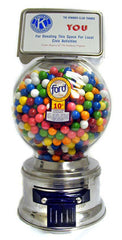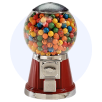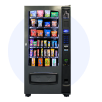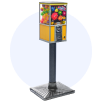History of Ford Gum

In 2013 Ford Gum celebrated 100 years of being in the bulk vending business. The history of this company dates all the way back to 1913 when a 20 year old Ford Mason took out a loan to lease a large route of gumball vending machines.
He was initially working as a roofer but needed a way to supplement his income in the cold winter months when the roofing business was slow. He discovered the relatively new vending industry and decided to take out a loan to lease 102 vending machines. At that time gumballs would vend for one penny. Ford recognized potential in the gumball vending business and three years later quit his roofing job to focus on vending full time.
During this time gumball machines began to garner a negative reputation. The machines were inconsistent and the gum that was dispensed was often of poor quality. This unsettling trend bothered Ford. He sought to infuse his business with integrity and overcome negative public perception. He worked with his father, a Baptist minister, develop a new machine that was more dependable. Using the church building as a headquarters to his fledgling business, he eventually developed and patented a new model machine. In 1917 he began manufacturing the gumball machine designed by his father and named his company Ford Vending Machine Co. Two years later Ford’s father, Wallace N. Mason, was issued a Patent for “new and useful Improvements in Vending Machines.”
In 1934 after years of successful business gained Ford a favorable reputation, he moved his company to Lockport, New York and renamed the company: Ford Gum & Machine Co. The new headquarters housed the manufacturing operation for the machines and gumballs.

Continuing his custom of combining integrity with innovation, Ford sought out a new marketing technique during the height of the great depression. He began selling his penny machines to charities that would split the profits with their organization. This revolutionary infusion of business with charity gave potential customers more than one reason to purchase Ford Gum. In the 1950’s Ronald Reagan was commissioned to record radio promotions. Transcribed here:
“This is Ronald Reagan speaking. I suggest you look for conveniently located gumball or chicle chew machines sponsored by your local Kiwanis club in your favorite neighborhood shopping area. A big share of your purchase price, still just a penny, is made available for service clubs throughout America to provide programs combating delinquency, and aids for crippled and handicapped children, when other funds are not available. This is just one of the many ways service clubs exercise their freedom to serve. The local Kiwanis club receives many dollars each year, enabling it to carry on and assist many worthwhile efforts helping boys and girls. Everyone; men, women, boys, and girls, will find real satisfaction by chewing and doing. Make sure the gum is branded Ford and in a Kiwanis sponsored machine.”
“This is Ronald Reagan speaking. Help your local Lions Club as it endeavors to help needy boys and girls by quickly finding a club sponsored machine that contains ball gum or chicle chew branded Ford. Service clubs all over America sponsor this program. Look for them in your favorite shopping area. Through this Fordway Plan the local lions club is exercising its right of freedom to serve by assisting less fortunate boys and girls in many ways when other funds are not available. Make your pennies count by chewing lion sponsored gum. This is a real American way of serving our needy neighbors; keeping our nation great.”
Ford always made charitable contributions as a part of his business plan. Some attribute his altruistic disposition to his upbringing in his father’s church. Whatever the cause, Ford’s strategy to combine charity with his business is one of the reasons his company was able to survive when many others failed.
Along with this method he also introduced other new practices into the industry. He hired solicitors to venture into new markets and establish vending routes. After the vending routes had been established they would then be sold to a local operator and run independently. Before this time bulk vending was considered a mom and pop business. The industry was now being run at a much larger scale.
In order to distinguish his product from other lower quality gumballs, Ford began branding his name on each gumball. This was important enough to him; he had to seek out a printing company capable of printing on the curved side of a gumball. In 1954 R.W. Hartnett was one of the only companies able to complete this task and developed a machine that could print on the round surface of the gumball. Hartnett’s partnership with Ford helped them gain a positive reputation that continued into printing on other confectioners and pharmaceutical items. Today, Ford still has two of the original Hartnett machines.
As brand recognition grew, so did demand for Ford Gum. Even World War II couldn't stop the public’s request for Ford Gum. This high level of demand combined with wartime shortages of metal and sugar contributed to a large back order. In 1945 Ford bought two DC-3 transport planes to quicken deliveries and eliminate the backlogs that had grown to over wartime. It took over two years but the backlogs eventually diminished.
Then, in 1970, after Ford Mason had spent over 50 years in the bulk vending industry, he retired. The company was purchased by Automatic Service Co., which owned several other distributing and manufacturing companies.
In 1985 Ford Gum was sold to Leaf Inc., along with Carousel Industries. Both were then purchased by The Hershey Company in 1996. A year later, Ford’s management bought back the company along with Carousel to return the business back to its independence. They continue to operate out of Akron, NY and are the only major gumball manufacturer in the United States.

The practice of producing a single gumball takes two days and eight processes. Even with this time costly system Ford is still able to manufacture over three million gumballs every day. That equates to over 700 million gumballs a year.
2013 marks the 100 year anniversary of Ford Gum. Their steady growth from the meager part time job of a roofer, to the only major U.S. gumball manufacturer, can be attributed to many different factors. The first being Ford’s commitment to quality and integrity. Other companies that tried to peddle inferior product soon found themselves out of business. Ford’s high quality gum and reliable machines set a standard that was soon recognized and appreciated by consumers. They can also attribute their success to the infusion of charity to their business. The altruistic tactic employed by Ford distinguished the brand by giving customers the ability to assist charitable endeavors while enjoying their product.
If Ford Gum’s history of adaptation and growth foreshadow anything about their future as a business, they could continue to produce delicious gum for another 100 years.
Here is some historical reporting of the Ford Gum Factory shown through terrible video quality:
Click to shop for gumball products made by Ford Gum.
To read the official version of the History of Ford Gum (click here) to visit the company website.



